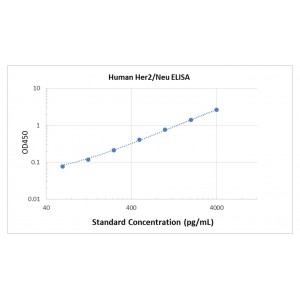Data sheet
| Background | Receptor tyrosine-protein kinase erbB-2, also known as CD340 (cluster of differentiation 340), proto-oncogene Neu, Erbb2 (rodent), or ERBB2 (human), is a protein that in humans is encoded by the ERBB2 gene. ERBB is abbreviated from erythroblastic oncogene B, a gene isolated from avian genome. It is also frequently called HER2 (from human epidermal growth factor receptor 2) or HER2/neu. HER2 is a member of the human epidermal growth factor receptor (HER/EGFR/ERBB) family. Amplification or over-expression of this oncogene has been shown to play an important role in the development and progression of certain aggressive types of breast cancer. In recent years the protein has become an important biomarker and target of therapy for approximately 30% of breast cancer patients. Amplification, also known as the over-expression of the ERBB2 gene, occurs in approximately 15-30% of breast cancers. It is strongly associated with increased disease recurrence and a poor prognosis; however, drug agents targeting HER2 in breast cancer have significantly positively altered the otherwise poor-prognosis natural history of HER2-positive breast cancer. Over-expression is also known to occur in ovarian, stomach, adenocarcinoma of the lung and aggressive forms of uterine cancer, such as uterine serous endometrial carcinoma, e.g. HER-2 is over-expressed in approximately 7-34% of patients with gastric cancer and in 30% of salivary duct carcinomas. HER2 is colocalised and most of the time, coamplified with the gene GRB7, which is a proto-oncogene associated with breast, testicular germ cell, gastric, and esophageal tumours. HER2 proteins have been shown to form clusters in cell membranes that may play a role in tumorigenesis. Recent evidence has implicated HER2 signaling in resistance to the EGFR-targeted cancer drug cetuximab. |
| Alternate Names | ERBB2, CD340, HER-2, HER-2/neu, HER2, MLN 19, NEU, NGL, TKR1, erb-b2 receptor tyrosine kinase 2 |
| Assay Type | Sandwich ELISA |
| Kit Type | Colorimettric |
| Assay Time | 4.5 hours |
| Sample Type | plasma, serum, other bodyculture supernatant, other body fluid like urine, milk. |
| Assay Range | 62.5pg/mL-4000pg/mL |
| Sensitivity | 43 pg/mL |
| Specificity | No detectable cross-reactivity with any other proteins. |
| Recovery | 91 - 106% |
| Precision | Intra -Assay, 4.1%; Inter-Assay 7.3% |
| Sample Volume | 100 uL |
| Dilution Factors | 1:2 dilution for plasma and serum, no dilution for urine. |
| Gene ID | 2064 |
| UniProt ID | P04626 |
More info
Storage
Store at 4 for frequent use, at -20 for infrequent use.
Avoid multiple freeze-thaw cycles (Shipped with wet ice.)
Expiration
Six months at 4 and eight months at -20.
Application
For quantitative detection of human ErbB-2 in serum,
plasma, body fluids, tissue lysates or cell culture supernates.
Kit Components
1. Lyophilized recombinant human ErbB-2 standard: 4ng/tube-2.
2. One 96-well plate precoated with anti- human ErbB-2 antibody.
3. Sample diluent buffer: 12 ml x 2
4. Biotinylated anti- human ErbB-2 antibody: 180µL, dilution 1:60.
5. Antibody diluent buffer: 12ml.
6. Streptavidin-HRP: 300µL, dilution 1:40.
7. Streptavidin-HRP diluent buffer: 12ml.
8. TMB 6 ml, H2O2 6 ml
9. Stop solution: 10ml.
Receptor tyrosine-protein kinase erbB-2, also known as CD340 (cluster of differentiation 340), proto-oncogene Neu, Erbb2 (rodent), or ERBB2 (human), is a protein that in humans is encoded by the ERBB2 gene. ERBB is abbreviated from erythroblastic oncogene B, a gene isolated from avian genome. It is also frequently called HER2 (from human epidermal growth factor receptor 2) or HER2/neu.
HER2 is a member of the human epidermal growth factor receptor (HER/EGFR/ERBB) family. Amplification or over-expression of this oncogene has been shown to play an important role in the development and progression of certain aggressive types of breast cancer. In recent years the protein has become an important biomarker and target of therapy for approximately 30% of breast cancer patients.
Amplification, also known as the over-expression of the ERBB2 gene, occurs in approximately 15-30% of breast cancers. It is strongly associated with increased disease recurrence and a poor prognosis; however, drug agents targeting HER2 in breast cancer have significantly positively altered the otherwise poor-prognosis natural history of HER2-positive breast cancer. Over-expression is also known to occur in ovarian, stomach, adenocarcinoma of the lung and aggressive forms of uterine cancer, such as uterine serous endometrial carcinoma, e.g. HER-2 is over-expressed in approximately 7-34% of patients with gastric cancer and in 30% of salivary duct carcinomas.
HER2 is colocalised and most of the time, coamplified with the gene GRB7, which is a proto-oncogene associated with breast, testicular germ cell, gastric, and esophageal tumours. HER2 proteins have been shown to form clusters in cell membranes that may play a role in tumorigenesis. Recent evidence has implicated HER2 signaling in resistance to the EGFR-targeted cancer drug cetuximab.
Please contact us for current kit manual at techsupport@novateinbio.com.
Human ErbB-2 ELISA Kit-1X96 Well Plate Image


